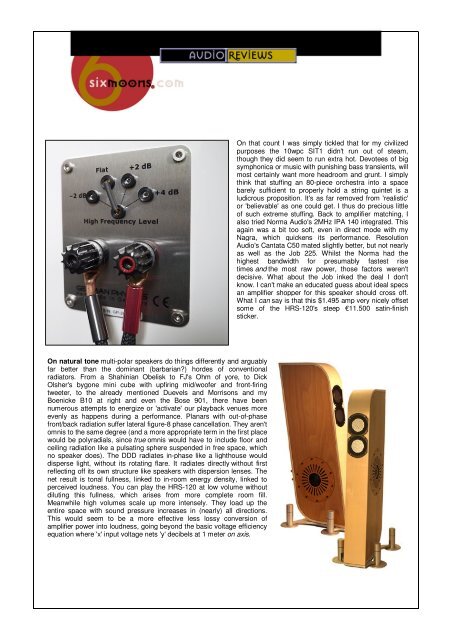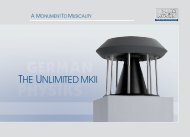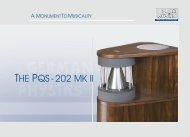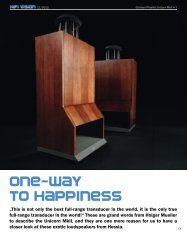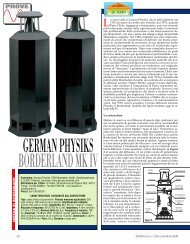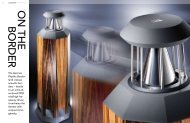Download 6Moons test report. July 2013 (PDF). - German Physiks
Download 6Moons test report. July 2013 (PDF). - German Physiks
Download 6Moons test report. July 2013 (PDF). - German Physiks
You also want an ePaper? Increase the reach of your titles
YUMPU automatically turns print PDFs into web optimized ePapers that Google loves.
On natural tone multi-polar speakers do things differently and arguably<br />
far better than the dominant (barbarian?) hordes of conventional<br />
radiators. From a Shahinian Obelisk to FJ's Ohm of yore, to Dick<br />
Olsher's bygone mini cube with upfiring mid/woofer and front-firing<br />
tweeter, to the already mentioned Duevels and Morrisons and my<br />
Boenicke B10 at right and even the Bose 901, there have been<br />
numerous attempts to energize or 'activate' our playback venues more<br />
evenly as happens during a performance. Planars with out-of-phase<br />
front/back radiation suffer lateral figure-8 phase cancellation. They aren't<br />
omnis to the same degree (and a more appropriate term in the first place<br />
would be polyradials, since true omnis would have to include floor and<br />
ceiling radiation like a pulsating sphere suspended in free space, which<br />
no speaker does). The DDD radiates in-phase like a lighthouse would<br />
disperse light, without its rotating flare. It radiates directly without first<br />
reflecting off its own structure like speakers with dispersion lenses. The<br />
net result is tonal fullness, linked to in-room energy density, linked to<br />
perceived loudness. You can play the HRS-120 at low volume without<br />
diluting this fullness, which arises from more complete room fill.<br />
Meanwhile high volumes scale up more intensely. They load up the<br />
entire space with sound pressure increases in (nearly) all directions.<br />
This would seem to be a more effective less lossy conversion of<br />
amplifier power into loudness, going beyond the basic voltage efficiency<br />
equation where 'x' input voltage nets 'y' decibels at 1 meter on axis.<br />
On that count I was simply tickled that for my civilized<br />
purposes the 10wpc SIT1 didn't run out of steam,<br />
though they did seem to run extra hot. Devotees of big<br />
symphonica or music with punishing bass transients, will<br />
most certainly want more headroom and grunt. I simply<br />
think that stuffing an 80-piece orchestra into a space<br />
barely sufficient to properly hold a string quintet is a<br />
ludicrous proposition. It's as far removed from 'realistic'<br />
or 'believable' as one could get. I thus do precious little<br />
of such extreme stuffing. Back to amplifier matching, I<br />
also tried Norma Audio's 2MHz IPA 140 integrated. This<br />
again was a bit too soft, even in direct mode with my<br />
Nagra, which quickens its performance. Resolution<br />
Audio's Cantata C50 mated slightly better, but not nearly<br />
as well as the Job 225. Whilst the Norma had the<br />
highest bandwidth for presumably fas<strong>test</strong> rise<br />
times and the most raw power, those factors weren't<br />
decisive. What about the Job inked the deal I don't<br />
know. I can't make an educated guess about ideal specs<br />
an amplifier shopper for this speaker should cross off.<br />
What I can say is that this $1.495 amp very nicely offset<br />
some of the HRS-120's steep €11.500 satin-finish<br />
sticker.


